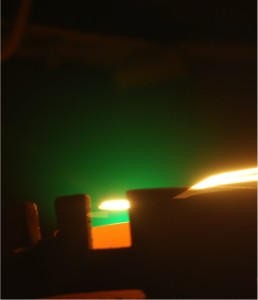The Thermoionic Vacuum Arc (TVA) plasma
Background
The Thermoionic Vacuum Arc (TVA) is a PVD technique. It is used for the deposition of metal, semiconductor and hydrogen-free and hydrogenated diamond like carbon (DLC) films on different substrates: metals, glass, ceramic and organic materials.
The basic principle of the TVA is ignition of an anodic arc plasma in the vapors of the material of interest which can be either a metal, a semiconductor or graphite. No buffer gas is needed.
The film is created by both neutral atoms and energetic ions of anode material. The ionic species have energies of hundreds eV. In TVA plasma, the vapor-phase species are obtained by evaporation while ion transport from the source to substrate takes place without collisions. The deposition rate is controllable and can be as low as 0.2 nm/sec but can also get to 70 nm/sec, depending on deposition parameters and anode material.
The TVA plasma source works under vacuum of 10-6 torr.
This deposition method was discovered over 25 years ago by the Romanian professor Geavit Musa at the Low Temperature Plasma Lab of the National Institute for Lasers, Plasma and Radiation Physics (INFLPR) [1, 2]. A the time, the TVA plasma could be used with solid precursors and the films were metallic or DLC.
The TVA plasma source was continuously studied and improved in our Laboratory. A series of plasma sources derived from TVA were developed, a wide window of possible applications being thus opened.
G-TVA – Gaseous TVA uses precursors in gas state only and could be used for the deposition of Hidrogenated-DLC films as well as of other materials contained in the gas precursor [3].
C-TVA – Compact/Ceramic TVA uses simultaneously gas and solid precursors to deposit ceramic films. This plasma technology has a rare characteristic: it provides a confined plasma without using magnetic fields [4].
S-TVA – Spherical particles TVA is able to synthesize metal spherical particles of 20 – 900 microns diameter [4].
LS-TVA – Large Scale TVA is a unique plasma source capable of depositing thin films with thickness uniformity at the atomic level over very large areas: 420 mm width and several meters in length [5]
Further details could be found in our publications.
REFERENCES
[1] Geavit Musa, Nicolae Betiu, Ion Mustata et Alexandra Baltog, « Low Voltage Arc Welding in Vacuum », Revue Roumaine de Physique, vol. 28, no 10, , p. 907–908
[2] Geavit Musa, Alexandra Baltog, Alexandra Popescu et Nicolae Betiu, « Electrical and Spectral Characteristics of a Heated Cathode Discharge in metal Vapors », Contributions to Plasma Physics, vol. 26, no 3, , p. 171–177
[3] G. Musa, C. Surdu-Bob, Patent No. 123002/30.06.2010.
[4] C. Surdu-Bob, M. Badulescu, The C-TVA plasma source, Techconnect World Summit and Innovation – Washington, 2013.
[5] C.C. Surdu-Bob, M. Bavdaz, M. Badulescu et al, Custom-made large scale plasma coating equipment for deposition of highly uniform DLC nanofilms for the ATHENA telescope mirror, ICSO24
